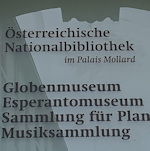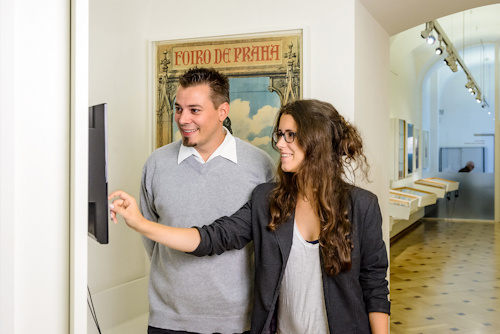
The National Library in Vienna includes a world-beating specialist section for planned languages. No wonder, then, that the same institution is home to the Esperanto Museum.
- Quick multimedia introductions to the language, history, and philosophy of Esperanto (and other planned languages)
- Located in the 17th-century Palais Mollard
- All display info is in German, English, and Esperanto
- Close to the famous Café Central coffee house
- See also:
La Esperanto-Muzeo

(Exhibition view inside the museum; press photo © Österreichische Nationalbibliothek/Pichler)
Bonvenon al Vieno, which means welcome to Vienna (I think) in Esperanto.
The city has hosted the World Esperanto Congress four times (most recently in 1992) and has a strong historical connection to the constructed language.
After all, Esperanto’s origins go back to the late 1800s, and the prospect of a shared language across borders had inherent appeal in the multilingual Austro-Hungarian Empire.
Founded in 1927, the Esperanto Museum lives in Palais Mollard: one-time neighbour of the 19th-century police censorship office.

(Palais Mollard houses two museums)
The core of the building dates back to the late 17th century, but numerous alterations, renovations, and refurbishments have changed the look since.
Inside, the museum occupies just a couple of rooms, but enough to give you a brief insight into the relevant concepts.
Videos and displays introduce you to the history of the institution and language, and also explain the linguistic principles behind the latter (with the help of a Pac-Man-like game!).
The museum also outlines the philosophy underpinning Esperanto’s development: a humanitarian vision and promotion of intercultural understanding.

(Exhibition view inside the museum; press photo © Österreichische Nationalbibliothek/Pichler)
With such a raison d’être, you can understand how the ideas enshrined within the Esperanto movement have influenced such modern-day concepts as the EU, the Euro, and even brand names.
Inevitably (and sadly), an ostensibly linguistic activity has sometimes enraged various authorities with little love for such concepts as “a humanitarian vision” and “intercultural understanding”.
For example, Hitler (surprise!) banned Esperanto, and the Gestapo closed the Vienna museum in March 1938. The museum’s first director – Hugo Steiner – even spent time in a Nazi concentration camp.
The museum also gives a nod to other artificial languages, from Homer’s efforts through to Klingon.
Indeed, if you happen to be in town during the Long Night of Museums, you can typically attend Esperanto and Klingon classes as part of the evening entertainment put on by the National Library.
Tickets & visitor tips
Entry to the Esperanto Museum requires a combination ticket that also covers the Globe Museum (in the same building). An adult ticket cost €5 at the time of writing.
If you fancy a cup of coffee after your visit, meander further down the street to Café Central, possibly the best-looking coffee house in all Vienna (but expect queues).
Alternatively, go up the road in the other direction to reach Michaelerplatz square: a gateway to the pedestrianised part of the centre and one entrance to the imperial Hofburg palace complex.
How to get to the Esperanto Museum
Palais Mollard has its own subway station practically outside the front door: the aptly-named Herrengasse station on the U3 line. The 1A and 2A buses also drop you nearby at the Michaelerplatz or Herrengasse stops.
Address: Herrengasse 9, 1010 Vienna | Website